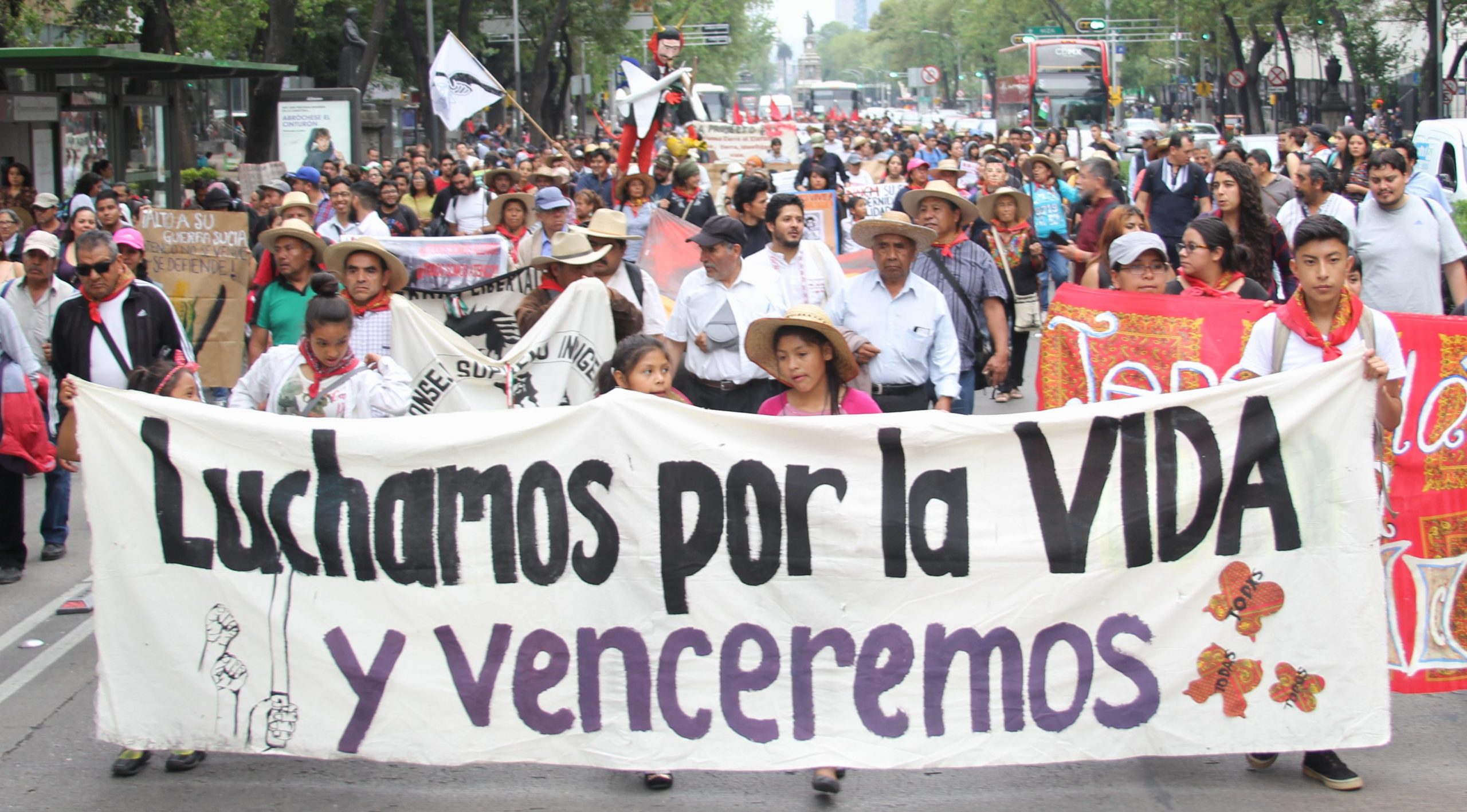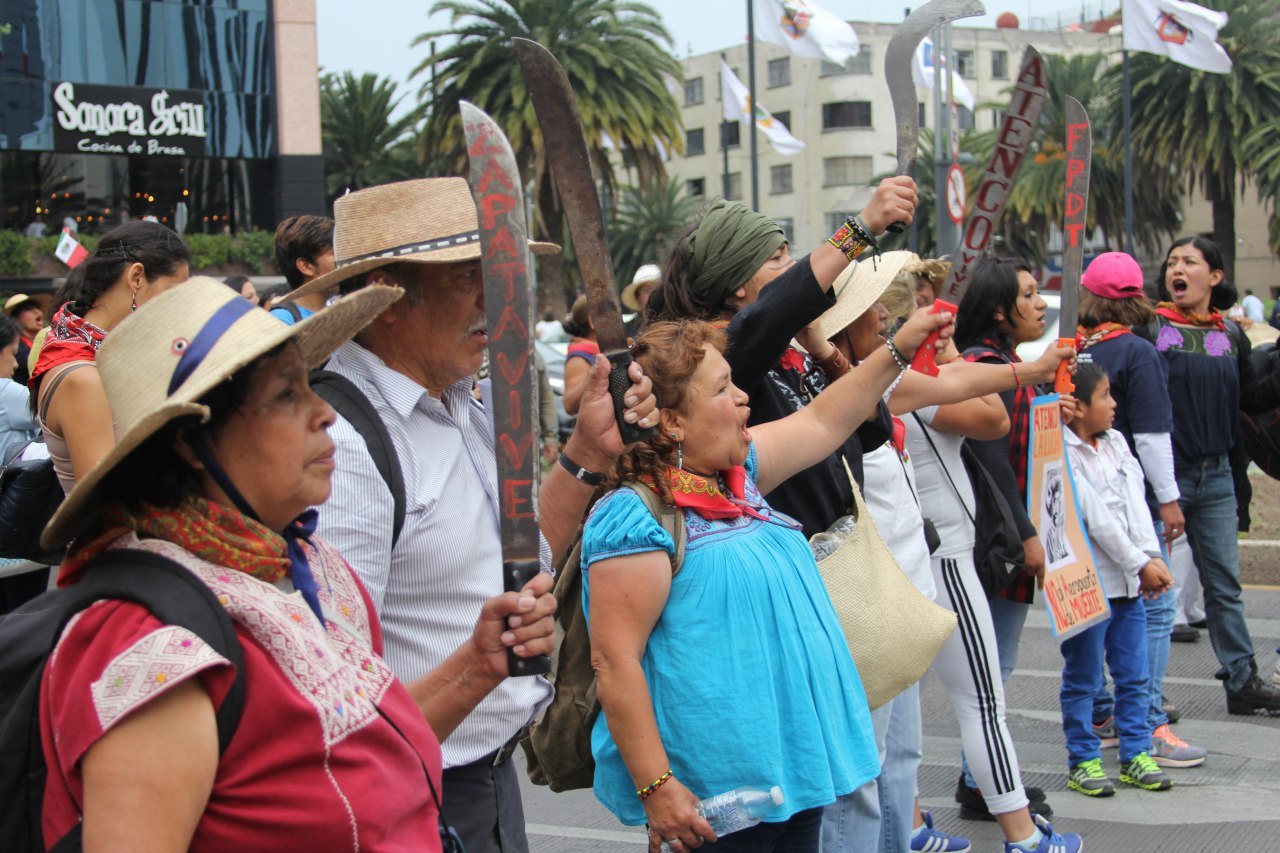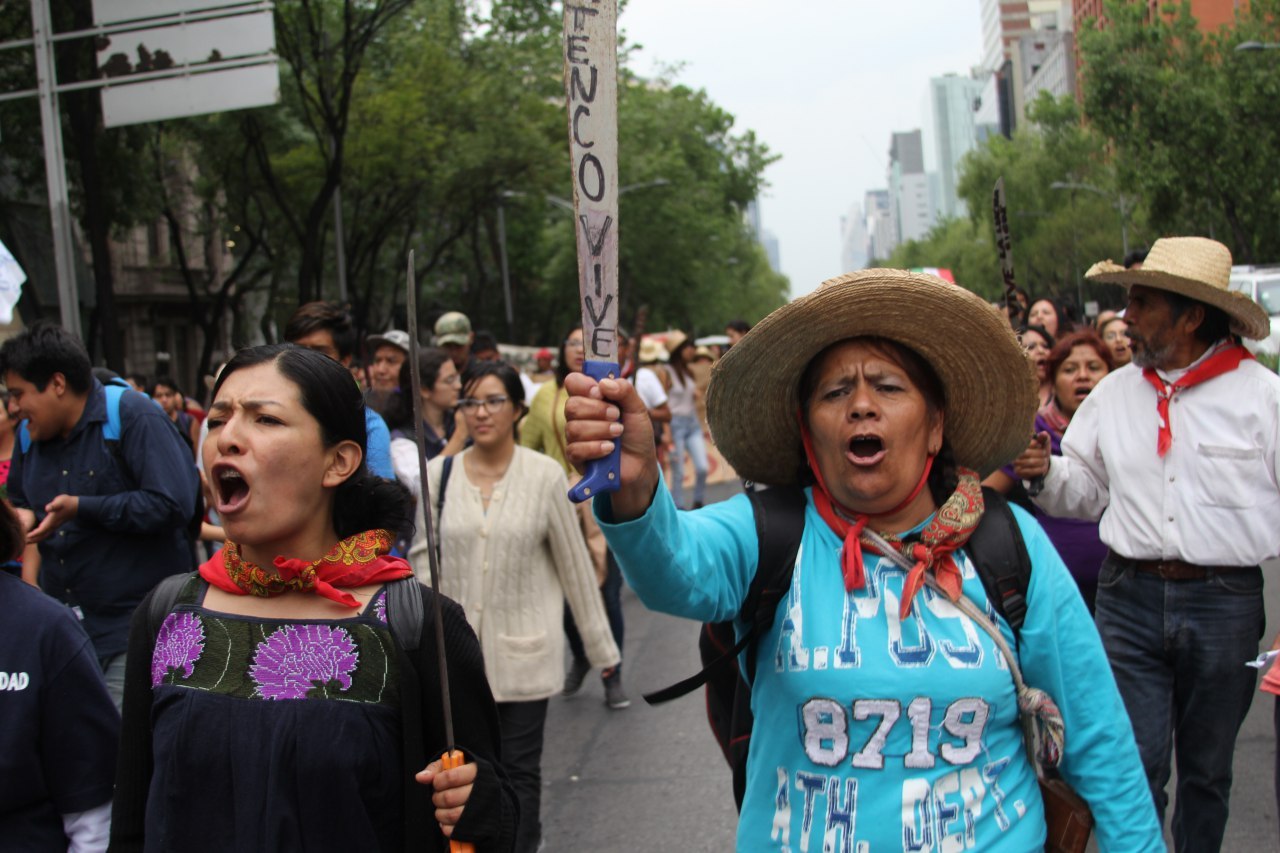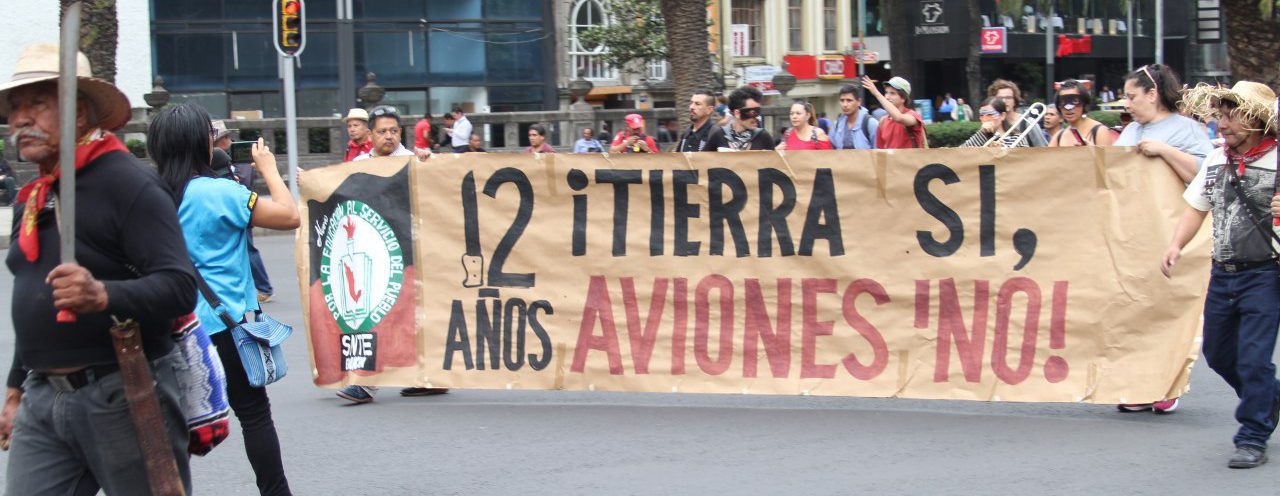Filed under: Analysis, Environment, Indigenous, Land, Mexico, Repression

The following is a translation by Voices in Movement of a text originally published by Radio Zapote. It offers a chronology of the struggles of the community of San Salvador Atenco in the State of Mexico, beginning with the brutal repression they faced in May 2006 up to their current resistance to the construction of a new international airport on their lands.
Just after the 4th of Mayo Rojo (Red May) in 2006:
On her knees above the furrow drawn beautifully in the earth, while vigorously pulling up the weeds, small stones become stuck in her skin opening small cuts. The weight of tragedy, pain, repression. The paths walked, the meetings, the speeches, the interviews, the words, the scandals, the lies. The tears and impotence accumulate on Doña Trinidad’s back, a woman committed to defending life. Now, she works the land alone, on that small piece of ejido that has fed them for generations. That territory, full of traditions, of joy, of dignity. A territory that sent her husband and children to prison for defending their land, the land of all, against the selfish interests of individuals.
A plane flies over the ejido of San Salvador Atenco. Its shadows draw on the brown earth, on the greenery, on the small houses scattered here and there. The turbines are loud and very close, just like the imminent threat of construction of the New International Airport of Mexico City (NAICM). Its noise covers everything. For moments it would seem that there is no hope, that there is no option yet to surrender. Doña Trinidad squinches her eyes with all her force, looking inward. She buries her hands in the earth, as if it is the only secure space. Feeling its liveliness between her fingers. There in mother earth something vibrates stronger than everything, life, hope and thought, everything will be ok.
In 2007, complaints related to the Atenco case continue: irregularities, case manipulations, the fabrication of evidence, delayed justice and nothing expedited. Furthermore, the impunity characteristic of judicial processes. During this time, the 27 detained in the operation in San Salvador Atenco and Texcoco remain imprisoned, some others worked through their legal cases from outside the prison. Petitions from organizations like the United Nations Development Fund for Women (UNIFEM), Amnesty International (AI), the United Nations, and other international human rights organizations, said the same: “Punish those who are responsible and provide justice to the women”.
In March of 2008, the Spanish judge Fernando Grande-Marlaska asked for information regarding the ongoing investigations into the violations against the women of Atenco and against the Spanish citizen Christina Valls. The Mexican state responded with “omission and imprecision” as was expressed in the declarations of the Human Rights Center Miguel Agustín Pro Juárez (Prodh). In August of 2008, Prodh intervened in the case of María Patricia Romero Hernández. She was unjustly imprisoned in the penal of Molino de Flores, together with her father Raúl Romero Macías and her son Arturo Sánchez Romero. They were accused for the infliction of injuries, insulting authority and the possession of a prohibited firearm in spite of the contradictions found in the testimonies of the police who had accused them.
On February 12th, 2009, after a four-day session in the National Supreme Court of Justice (SCJN), the ruling on the Atenco Case was issued. The Department of Justice had the historic opportunity to bring justice to the people whose human rights and individual guarantees had been gravely violated. However, with the resolution of the Supreme Court, the governor of the state of Mexico Peña Nieto was not held responsible, nor the state functionaries like Eduardo Medina Mora, Miguel Ángel Yunes, among others. With this resolution, the court authorized impunity for the repressors.
In the beginning of July of 2010, due to an opinion of the National Supreme Court of Justice, 12 political prisoners were released. The Mexican government had maintained these political prisoners incarcerated since May of 2006 from the events in Atenco. Three of them had spent those four years in high-security prison, in near complete isolation. Ignacio del Valle, a prominent member of the People’s Front in Defense of the Land (FPDT) had been condemned to 112 years in prison. In July of that same year, América del Valle would meet with Doñi Trini and her other relatives after four years of forced isolation due to the persecution, continuing the land defense.
A year afterwards, in November of 2011, the (CIDH) agreed to look at the lawsuit filed by Mariana Selvas, Georgina Edith Rosales, María Patricia Romero, Norma Aidé Jiménez, Claudia Hernández, Bárbara Italia Méndez, Ana María Velasco, Yolanda Muños, Christina Sánchez, Patricia Torres and Suhelen Gabriela Cuevas. These women had denounced the sexual torture committed during the deployment of nearly 3000 police officers in Atenco and Texcoco.

During 2012, the FPDT would join the calls of the Yo Soy 132 movement, in particular the encampment and blockade at the entrance of Televisa which lasted 24 hours. That same year, they denounced the case of Valentina Palma, a Chilean student who was assaulted in Atenco in 2006. Palma had suffered intimidation through an email demanding that she drop her accusations against the Mexican state. Also, in 2012, they convoked the national conventions against the imposition of the now president Enrique Peña Nieto. They joined and demanded justice for the assassinated in the Purépecha community of Cherán.
In March of 2013, “The Mexican Government called on the CIDH to refer the matter to the court to consider the adequacy of reparation matters, in light of Interamerican standards”. This posture was taken after a failed attempt on part of the Mexican State to negotiate a “friendly” solution with the victims. In the context of a hearing that took place in the headquarters of the CIDH in Washington, Lía Limón and Juan Manuel Gómez-Robledo, then undersecretaries of the Interior, offered to close the case with a “friendly solution”. That is to say, to make an agreement between the victims and the Mexican State to discontinue the International Litigation. This offer was rejected by survivors of the sexual violence (ANTAC, Anayelo García Martínez, 2016).
In 2014, two years after Enrique Peña Nieto took power, he announced his revenge: The New International Airport of Mexico City would be built. In an extravagant ceremony presenting the project, he explained that, “Because of its magnitude, design, and social benefit, it would be a transcendental work, emblematic of a modern Mexico”. In the same presentation, he argued that with the construction of the airport, more than 160,000 people would be employed directly or indirectly, and it would encourage the hiring of hundreds of small and medium sized businesses. This was of course false.
In January of 2015, the Grupo de Análises de Manifestaciones de Impacto Ambiental y la Unión de Cientificos Comprometidos con la Sociedad carried out a study. In agreement with the consultation of specialists and with bibliographic support, they concluded that the construction of, “…the New International Airport of Mexico City, S. A. of C. V. should have been rejected by the Environmental Impact and Risk Directorate (DGIRA). This is due to the existing uncertainty related to the project which arose from the deliberate omission of information obstructing a correct evaluation of its possible environmental impact”. Here we share the technical deficiencies of the Environmental Impact Statement, that which the DGIRA approved in an incorrect manner. They are:
- The project includes the planting of 264, 534 exotic invasive species as one of the principle means of compensation.
- The construction of the project violates the Regional Plan of Urban Development of the Cuautitlán-Texcoco Valley.
- The project seeks to be constructed in a highly vulnerable zone and omits the presentation of the Studies of Environmental Risk associated with the possibility of floods during hydrometeorology events.
- There does not exist sufficient techniques to assure that the hydraulic works that supposedly divert the runoff are adequate to prevent flooding in the project area and in the surrounding zonea.
- The project intends to duplicate and improve the environmental quality of the wetlands. However, not one bit of information has been presented regarding how these new bodies of water will be created or maintained.
- There are no scenarios allowing for the evaluation of the effects on water inside the municipal network of drinking water for each one of the stages of the project.
- The promoter completely omitted the estimated use of water for the Airport Metropole, an urban zone where 180,000 people will regularly work. This implies an additional 23.6 million cubic meters yearly, what would be an enormous pressure for the water resources of the region.
- The technical elements necessary to evaluate the impact on bird populations are completely deficient. They deliberately omit information, do not have a program adequate to manage the birdlife, nor to minimize the risk of collision between the birds and the planes. Furthermore, they propose incorrect and unjustified actions.
- The risk study regarding the fuels that will be used underestimates the risks associated with catastrophic events. (Analysis of operative SGPA/DGIRA/DG/09965 of the project “New International Airport of Mexico City, S. A. of C. V.” MIGA-15EM2014V0044, 2015)
- In that same year, in October 2015, several people that were detained during the repression of 2006 were summoned. Among them was the free media worker Ken Luders, who together with his brother were brutally beaten and detained for more than a week, while they carried out an interview in the context of the Mayo Rojo (Red May). After this summons a series of constant harassments and threats took place.
On October 27th, outside of his house, a group of police arrived with an order of presentation signed by the Judge of the First Criminal Court of the First Instance of the Federal District of Toluca. The police took photos of Luders who refused to accompany them. “You will not fuck us. You know that they are remanding our friends for your bullshit. You are the ones that submitted the notes. You are going to have to accompany us”, they told him.
According to Mas de 131, the summons sought a declaration from Luders against Daniel Job Olmos Arroyo, remanded for coverup, and Agustín Hinojosa, remanded for sexual torture against 11 women. This complaint was filed by the Interamerican Court of Human Rights, which recommended reparation for damages. Luders refused to present himself for the declaration, arguing that it is not the manner in which justice should be served in the Atenco case. Two months afterwards, on December 30th, he was found dead in his apartment, beneath uncertain circumstances (Más de 131, 2015).

During 2016, The People’s Front in Defense of the Land reactivated their organization with more force and began the land defense by means of appeals and a strategy based in scientific facts. On the other hand, the government of the state of Mexico, led by then governor Eruviel Avila, prepared to repress the social movement by means of the Atenco Law. This law gave the state and municipal police the right to intervene when they considered a protest or demonstration “illegal”. This law legitimates the type of abuse that occurred in 2006 in Atenco. In that moment, several appeals had been filed. Below they are listed, as published in the blog of FPDT.
- Challenge against the illegal assembly on June 1st, 2014 that sought to privatize the ejidal land (file 400/2014 put before the Unitary Agrarian Tribunal of District 23) Appeal brought by ejido members of Atenco
- Direct appeal against the change of the use and destination of common use lands (1016/ 2014 granted by the 12th District Court in Nezahualcóyotl) Appeal brought by ejido members of Atenco
- Appeal against the approval of the NAICM project (File 14/2015 put before the Ninth District Court of the State of Mexico) Appeal brought by ejido members of Atenco
- Appeal against the dispossession by CONAGUA (File 514/2014 before the Fifth District Court of the State of Mexico) Appeal brought by Ejido members of Atenco
- Appeal against the decrees related to the limits of the lake bed of Texcoco (File 514/2014 put before the Fifth District Court of the State of Mexico) Appeal brought by Atenco
- Suspension Incident 349/2016-111 Ninth District Court of the State of Mexico in Ciudad Nezahualcóyotl. Brought by Ejido members of Tocuila
- Also since January 28th, 2015, the Interamerican Commission of Human Rights has been solicited to dictate precautionary measures for the defenders of the land of San Salvador Atenco, which is contained in the document MC-28-15. Brought by the FPDT
On June 28th, 2017, after bringing various appeals against the NAICM, the Federal Judicial Branch, through the Ninth District Court of the State of Mexico, with its base in Nezahualcóyotl, inside of the appeal trial 14/2015, decided to dismiss the case. Without studying the merits of the matter, the judge decided to end it.
Having suffered another setback, in November of 2017, during the 120th regular session of the Interamerican Court of Human Rights (Coridh), five of the 11 plaintiffs narrated the events in San Salvador Atenco on May 4th, 2006. They detailed the horror and atrocious actions carried out against them by the police. The plaintiffs appeared before this international court in search of justice.
On January 18th, 2018, the Second Collegiate Court ruled on the Writ of Appeal 383/2017. The appeal was brought by The People’s Front in Defense of the Land against the decision of the Ninth District Court of Nezahualcóyotl, who had before negated the appeal against the construction of the NAICM. The procedure worked according to the following terms: “The judge of the appeal ordered the expansion of the expert evidence in anthropology that had already been offered, with the intention to verify if the people of Atenco are Indigenous peoples and if they are comparable to an Indigenous town or community. Furthermore, to determine if the right in Article 2 of the constitution is applicable to them. The past month of April, in a press conference in the Center of Social Communication, Sandino Rivero, lawyer of the People’s Front assured that “there exists an appeal trial to protect the territory of the NAICM. However, a judge determined that it was not applicable because San Salvador Atenco was not an Indigenous community”.
On the other hand, different organizations accompanying the struggle of the Popular Front presented an investigation into the businesses carrying out the construction of the NAICM. Among them were the groups Projecto sobre Organización, Desarrollo, Educación e Investigación (PODER) and Servicios y Asesoría para la Paz (SERAPAZ). The project carried out by researchers and human rights defenders convoked by The People’s Front in Defense of the Land had the objective of better understanding the megaproject. Furthermore, they sought to reinforce the defense of the land of San Salvador Atenco. Their investigation covers businesses in charge of the construction of the New International Airport of Mexico City, such as the Grupo Aeroportuario de la Ciudad de Mexico (GACM), Netherlands International Consulting (NACO) and Parsons International.
In the document, available for download, they sketched out how it is that the Mexican government decided in 2002 to carry out the new airport. In turn, it details in a timely manner, the complex relationships with businesses, businessmen, the Grupo Aeroportuarío de Ciudad de Mexico and a long list of mismanagement that has occurred since the companies were given concessions for the project.

The Project
This project proposes the construction of a terminal, three runways, control tower, warehouses and hangars, in an area of approximately 4,500 hectares. This area is located in what now are federal lands, in the zone of the ex-lake of Texcoco. Furthermore, the construction of the project named Aerotrópolis brags of its intention to house businesses of international logistics, hotels and real estate developments, including a University with careers linked to aeronautics and aviation.
To carry out this “most emblematic” mega infrastructure project, a structure guided by some distinguishing features was created. Here, we briefly summarize the extensive and valuable investigation carried out during one year, necessary to understand the magnitude of national and international interests that continue pressuring for the construction of the airport.
The investigation shows that the birth of the Grupo Aeroportuario de Ciudad de Mexico, constituted may 28th, 1998, by the Federal Government and a decentralized organization Aeropuertos and Servicios Auxiliares (ASA). It was created with, “…the objective to acquire actions, interests and participation in already established societies dedicated to administer, operate, construct and operate civil airports or auxiliary and special services”.
Furthermore, to participate in the social capital of societies to carry out whatever type of service or operation such as taking credits and buying bonds. This same GACM secretly contracted several companies. The group is in charge of subcontracting other companies since it does not have the technical capacities for the construction of infrastructures.
One of the companies investigated and covered extensively in the document is Netherlands Airport Consultants B.V. (NACO) from Holland. NACO is the world leader in airport engineering and consulting, providing services in planning, design, and development for more than 600 airports in one hundred countries. “NACO was invited by Foster Partners and FREE to join the design team of the New International Airport of Mexico City (NAICM) to create an innovative solution that is unique and world class. NACO was contracted together with their Mexican associates TADCO Constructora and SACMAG, to carry out the project of tracks, roads, platforms and the navigation aids and other installations of the NAICM”.
In the section regarding questionable business practices carried out by the company, the investigation shows that in 2004, “The company did business in Guatemala with Jurg Widmer Probst, a powerful businessman known as “the Kind of the Ports”. Jurg Widmer Probst allegedly turned out to be an important part of the network of corruption revealed in 2015 in Guatemala—a network of corruption that would result in the arrest of the President Otto Pérez Molina. According to Guatemalan media, Probst is a fugitive”.
Without doubt, one of the most chilling characters in the investigation is Parsons International Ltd. According to the document, “In 2014, the private engineering and construction services company, Parsons Corporation, through its subsidiary Parsons International Ltd., obtained a contract of 2, 361 million pesos. The contract was for the position of General Manager of the NAICM project. The company was selected to provide “a wide range of services for the new airport of Mexico City including program and project management, contract administration and project control, design management, management supervision of the construction of the airport”. Parsons is the “Principal consultant for NAICM”. Founded in 1944 in California by Ralph M. Parsons, today the company has more than 15,000 employees around the world, who own 10% of the company. It is dedicated principally to developing projects in the areas of defense, security, industry and infrastructure.”
In the investigation, the company is shown to have produced problems in other airport projects like the expansion of the Miami-Dade airport, International Airport of Fort Lauderdale-Hollywood and two other projects like the Salt Waste Processing Facility, Savannah River, South Carolina. In 2010, the Department of Energy of the United Sates emitted a preliminary notification of violation with a penalty of 70,000 dollars to the subsidiary of Parsons, Parsons Infrastructure Technology Group, for the violations of health and security regulations of two workers.
The investigation also makes some points regarding the transparency in Parson’s transition from a public to private company. In 1985, Parsons Corporation went from being a public company listed in the New York Stock Exchange, to being a company totally “controlled by its workers”. In response to various worker demands, they filed a class action lawsuit against some subsidiaries, directors and investors of the Parsons Corporation, as well as of the Bank of America for the loan for the purchase.
The investigators make the following note: “In conclusion, it is important to note the connections between employees of Parsons at all levels of the organization and positions in the local and federal governments of the United States. Before the Mexican government directly awarded the contract of NAICM, Parsons contracted a group of three consultants highly connected to the high ranks of federal government and the companies that would benefit directly from the construction of the project: Alfredo Elías Ayub, Aaron Dychter and Felipe Ochoa. U.”
The investigation is an invaluable contribution in understanding the possible conflicts of interest with companies that have been sued and exhibited for their malpractice around the world. These are private companies contracted by the GACM. On the other hand, the independent media outlet, Sin Embargo, uncovered in an investigation the waste on part of these businesses: “According to open information of the Grupo Aeroportuario de Ciudad de Mexico (GACM) for the new airport (NAICM), so far, they have paid contracts that total 137, 232, 458, 145 pesos, the majority spent on Public Works. But that quantity of money also includes payments made to media, parking at the Feria del Caballo in Texcoco, workshops and even clothing” (Sin Embargo, Barragán, 2018).
On May 4th, 2018, The People’s Front in Defense of the Land (FPDT), paid homage to the student of UNAM, Ollín Alexis Benhumea Ramírez, assassinated from the impact of a tear gas canister shot by the police, on May 4th, 2006. This happened during the seizure of the town of San Salvador Atenco. “We demand punishment to those responsible for his assassination”, said the compañerxs of FPDT.
In the afternoon, hundreds of people gathered in the Ángel de Independencia, from where they marched to the Zócalo in Mexico City. During the march, compañerxs of different social organizations, like the National Coordinator of State Workers (CNTE), Supreme Indigenous Council of San Francisco Xochicuautla, Family members of the political prisoners of Tlanixco, troubadours, students, The Human Rights Center “Zeferino Ladrillero”, The Front in Defense of Tepoztlan and dozens of others, accompanied the march to the front of the National Palace. There, for 12 years, the defenders of life have reminded us that it is not the ultimate battle against the New International Airport of Mexico City. On the contrary, the struggle against (NAICM) is the beginning of a new stage of struggle against the humiliation, state crime, influence peddling, and human rights violations that were committed in 2006. Thanks to the dignified compañeras that have not taken their finger off the pulse in their demand for justice, a glimmer of hope remains.
Doña Trini suddenly appears and disappears. She can be recognized by her hat. She looks concerned, hoping the march and meeting will happen with order. As we move forward the march is short but hurried. It takes some work to sharpen the machete, but she does it. Her voice and her slogans resound in the hearts. She is undoubtedly, together with the FPDT, an example of resistance dictated in the streets, in the communities, where real examples of dignity and struggle exist. How will they do it, we ask? With the inexhaustible feeling of anger that does not subside.





